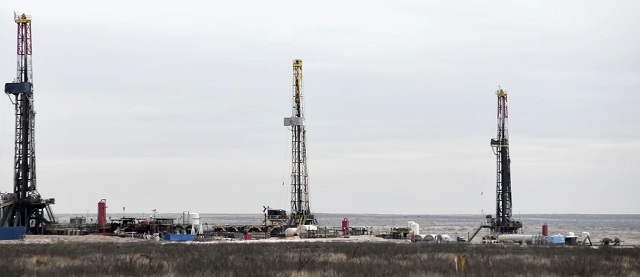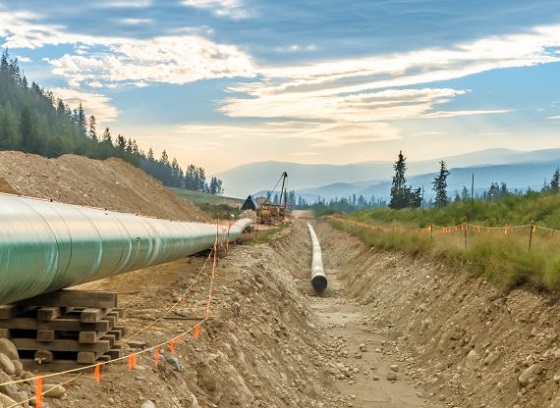Energy
Energy Companies May Be On Cusp Of Uncorking Next Massive Oil, Gas Boon

 From the Daily Caller News Foundation
From the Daily Caller News Foundation
These companies, all run by smart business people, continue to invest many billions of capital dollars in these risky, long-term projects even as “experts” like the bureaucrats at the International Energy Agency (IEA) continue to predict demand for crude oil is about to peak in the next few years.
Constantly advancing technology has always been the driver behind the advance of the oil-and-gas industry since the first successful U.S. well was drilled by Edwin Drake near Titusville, Pennsylvania, in 1859. The Drake well was drilled to a then unheard-of depth of 69 feet using the most primitive equipment imaginable.
This week, 165 years later, U.S. oil giant Chevron announced it had achieved first production in its Anchor field in the Gulf of Mexico. At its shallow depth, underground pressure in the Drake well would have been negligible, just enough to force the oil up out of the ground. The Anchor semi-submersible floating production unit (FPU) that was started up by Chevron this week enables the capture of massive volumes of oil and natural gas from underground formations up to 34,000 feet below sea level at pressures up to 20,000 pounds per square inch.
“The Anchor project represents a breakthrough for the energy industry,” said Nigel Hearne, executive vice president, Chevron Oil, Products & Gas. “Application of this industry-first deepwater technology allows us to unlock previously difficult-to-access resources and will enable similar deepwater high-pressure developments for the industry.”
Chevron says seven deepwater wells will be tied into the Anchor FPU, which has the capacity to capture, process and transport as much as 75,000 barrels of oil and 28 million cubic feet of natural gas every day. The company estimates reserves in the field of 440 million barrels of oil equivalent with current technology. But, again, the technology deployed by the industry advances every day, meaning a far bigger amount of oil and gas will ultimately be recovered over the coming years.
Other major oil companies, like BP, are also beginning to deploy similar high-pressure technology that they and analysts believe will help them tap into billions of new barrels known to exist in deep, high-pressure formations in various parts of the world. Globally, BP says it believes deployment of advanced technology could help it access up to 10 billion barrels of known high pressure reserves.
Reuters quotes Wood Mackenzie principal analyst Mfon Usoro as saying the new high pressure technologies could enable companies like BP and Chevron to unlock as much as 2 billion barrels of known reserves in the Gulf of Mexico alone. “The industry has done their bit to safely deliver the barrels, with the new technology,” she said, adding: “These ultra-high-pressure fields are going to be a big driver for production growth in the Gulf of Mexico.”
On the same day Chevron made its announcement, Chinese national oil company CNOOC announced the completion of what it believes is the largest offshore platform on Earth, the Marjan facility. The giant platform, which serves similar functionality as the Anchor FPO, will now be shipped 6,400 nautical miles to the Persian Gulf, where it will facilitate the full development of Saudi Arabia’s deepwater Marjan Field.
It is important to keep in mind that the mounting of these massive offshore facilities and drilling of the deepwater wells are all long-term, multi-billion-dollar projects. These are facilities designed to handle the production from these deepwater fields for decades, not just a few years until the vaunted energy transition takes away all the demand for the commodities being produced.
In addition to the projects in the Gulf of Mexico and Persian Gulf, all the companies mentioned here are involved in aggressive efforts to discover and produce oil and gas in deepwater regions around the world. CNOOC, for example, is a 20% owner in the prolific Stabroek block development offshore of Guyana operated by ExxonMobil. Chevron stands to become a 30% owner in that same development via its proposed buyout of Houston-based Hess Corp.
These companies, all run by smart business people, continue to invest many billions of capital dollars in these risky, long-term projects even as “experts” like the bureaucrats at the International Energy Agency (IEA) continue to predict demand for crude oil is about to peak in the next few years. Meanwhile, OPEC says it believes demand for crude will keep rising through at least 2045, perhaps longer.
Someone will be right, and someone will be wrong. Regardless, we can rest assured that advancing technology in the industry itself will ensure there will be no shortage of supply.
David Blackmon is an energy writer and consultant based in Texas. He spent 40 years in the oil and gas business, where he specialized in public policy and communications.
Featured image credit: (Screen Capture/PBS NewsHour)
Energy
75 per cent of Canadians support the construction of new pipelines to the East Coast and British Columbia

-
71 per cent of Canadians find the approval process too long.
-
67 per cent of Quebecers support the Marinvest Energy natural gas project.
“While there has always been a clear majority of Canadians supporting the development of new pipelines, it seems that the trade dispute has helped firm up this support,” says Gabriel Giguère, senior policy analyst at the MEI. “From coast to coast, Canadians appreciate the importance of the energy industry to our prosperity.”
Three-quarters of Canadians support constructing new pipelines to ports in Eastern Canada or British Columbia in order to diversify our export markets for oil and gas.
This proportion is 14 percentage points higher than it was last year, with the “strongly agree” category accounting for almost all of the increase.
For its part, Marinvest Energy’s natural gas pipeline and liquefaction plant project, in Quebec’s North Shore region, is supported by 67 per cent of Quebecers polled, who see it as a way to reduce European dependence on Russian natural gas.
Moreover, 54 per cent of Quebecers now say they support the development of the province’s own oil resources. This represents a six-point increase over last year.
“This year again, we see that this preconceived notion according to which Quebecers oppose energy development is false,” says Mr. Giguère. “Quebecers’ increased support for pipeline projects should signal to politicians that there is social acceptability, whatever certain lobby groups might think.”
It is also the case that seven in ten Canadians (71 per cent) think the approval process for major projects, including environmental assessments, is too long and should be reformed. In Quebec, 63 per cent are of this opinion.
The federal Bill C-5 and Quebec Bill 5 seem to respond to these concerns by trying to accelerate the approval of certain large projects selected by governments.
In July, the MEI recommended a revision of the assessment process in order to make it swift by default instead of creating a way to bypass it as Bill C-5 and Bill 5 do.
“Canadians understand that the burdensome assessment process undermines our prosperity and the creation of good, well-paid jobs,” says Mr. Giguère. “While the recent bills to accelerate projects of national interest are a step in the right direction, it would be better simply to reform the assessment process so that it works, rather than creating a workaround.”
A sample of 1,159 Canadians aged 18 and older were surveyed between November 27 and December 2, 2025. The results are accurate to within ± 3.5 percentage points, 19 times out of 20.
Business
Geopolitics no longer drives oil prices the way it used to

This article supplied by Troy Media.
Oil markets are shrugging off war and sanctions, a sign that oversupply now matters more than disruption
Oil producers hoping geopolitics would lift prices are running into a harsh reality. Markets are brushing off wars and sanctions as traders focus instead on expectations of a deep and persistent oil glut.
That shift was evident last week. Despite several geopolitical developments that would once have pushed prices higher, including the U.S. seizure of a Venezuelan crude tanker and fresh Ukrainian strikes on Russian energy infrastructure, oil markets barely reacted, with prices ending the week lower.
Brent crude settled Friday at US$61.12 a barrel and U.S. West Texas Intermediate at US$57.44, capping a weekly drop of more than four per cent.
Instead of responding to disruption headlines, markets were reacting to a different risk. Bearish sentiment, rather than geopolitics, continued to dominate as expectations of a “2026 glut” took centre stage.
At the heart of that outlook is a growing supply overhang. The oil market is grappling with whether sanctioned Russian and Iranian cargoes should still be counted as supply. That uncertainty helps explain why prices have been slow to react to a glut that is already forming on the water, said Carol Ryan, writing for The Wall Street Journal.
The scale of that buildup is significant. There are 1.4 billion barrels of oil “on the water,” 24 per cent higher than the average for this time of year between 2016 and 2024, according to oil analytics firm Vortexa. These figures capture shipments still in transit or cargoes that have yet to find a buyer, a clear sign that supply is running ahead of immediate demand.
Official forecasts have reinforced that view. Last week, the International Energy Agency trimmed its projected 2026 surplus to 3.84 million barrels per day, down from 4.09 million barrels per day projected previously. Even so, the IEA still sees a large oversupply relative to global demand.
Demand growth offers little relief. The IEA expects growth of 830 kb/d (thousand barrels per day) in 2025 and 860 kb/d in 2026, with petrochemical feedstocks accounting for a larger share of incremental demand. That pace remains modest against the volume of supply coming to market.
OPEC, however, has offered a different assessment. In its latest report, the group pointed to a near balance, forecasting demand for OPEC+ crude averaging about 43 million barrels per day in 2026, roughly in line with what it produced in November.
Reflecting that confidence. OPEC+ kept policy steady late in November, pausing planned output hikes for the first quarter of 2026 while more than three million barrels per day of cuts remain in place. Those measures are supportive in theory, but markets have shown little sign of being persuaded.
Recent geopolitical events underline that scepticism. The ongoing Russia-Ukraine war and Ukrainian strikes on Russian energy infrastructure, including reported hits on facilities such as the Slavneft-YANOS refinery in Yaroslavl, again failed to lift prices. Russia-Ukraine headlines pulled prices down more than strikes lifted them, according to media reports, suggesting traders were more attuned to “peace deal” risk than to supply disruption.
Washington’s move against Venezuelan crude shipments offered another test. The U.S. seizure of a Venezuelan tanker, the first formal seizure under the 2019 sanctions framework, had a muted price impact, writes Marcin Frackiewicz of Oilprice.com.
Venezuela’s exports fell sharply in the days that followed, but markets remained largely unmoved. One explanation is that Venezuela’s output is no longer large enough to tighten global balances the way it once did, and that abundant global supply has reduced the geopolitical premium.
Taken together, the signal is hard to miss. Oil producers, including in Canada, face a reality check in a market that no longer rewards headlines, only discipline and demand.
Toronto-based Rashid Husain Syed is a highly regarded analyst specializing in energy and politics, particularly in the Middle East. In addition to his contributions to local and international newspapers, Rashid frequently lends his expertise as a speaker at global conferences. Organizations such as the Department of Energy in Washington and the International Energy Agency in Paris have sought his insights on global energy matters.
Troy Media empowers Canadian community news outlets by providing independent, insightful analysis and commentary. Our mission is to support local media in helping Canadians stay informed and engaged by delivering reliable content that strengthens community connections and deepens understanding across the country.
-

 Crime2 days ago
Crime2 days agoBrown University shooter dead of apparent self-inflicted gunshot wound
-

 Business15 hours ago
Business15 hours agoGeopolitics no longer drives oil prices the way it used to
-

 Alberta1 day ago
Alberta1 day agoAlberta’s new diagnostic policy appears to meet standard for Canada Health Act compliance
-

 Health1 day ago
Health1 day agoRFK Jr reversing Biden-era policies on gender transition care for minors
-

 Business2 days ago
Business2 days agoTrump signs order reclassifying marijuana as Schedule III drug
-

 Business15 hours ago
Business15 hours agoDeadlocked Jury Zeroes In on Alleged US$40 Million PPE Fraud in Linda Sun PRC Influence Case
-

 COVID-191 day ago
COVID-191 day agoFreedom Convoy protester appeals after judge dismissed challenge to frozen bank accounts
-

 Censorship Industrial Complex1 day ago
Censorship Industrial Complex1 day agoCanadian university censors free speech advocate who spoke out against Indigenous ‘mass grave’ hoax











